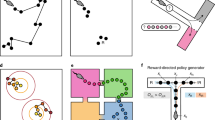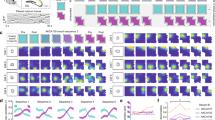Abstract
The trace version of classical conditioning is used as a prototypical hippocampal-dependent task to study the recoding sequence prediction theory of hippocampal function. This theory conjectures that the hippocampus is a random recoder of sequences and that, once formed, the neuronal codes are suitable for prediction. As such, a trace conditioning paradigm, which requires a timely prediction, seems by far the simplest of the behaviorally-relevant paradigms for studying hippocampal recoding. Parameters that affect the formation of these random codes include the temporal aspects of the behavioral/cognitive paradigm and certain basic characteristics of hippocampal region CA3 anatomy and physiology such as connectivity and activity. Here we describe some of the dynamics of code formation and describe how biological and paradigmatic parameters affect the neural codes that are formed. In addition to a backward cascade of coding neurons, we point out, for the first time, a higher-order dynamic growing out of the backward cascade—a particular forward and backward stabilization of codes as training progresses. We also observe that there is a performance compromise involved in the setting of activity levels due to the existence of three behavioral failure modes. Each of these behavioral failure modes exists in the computational model and, presumably, natural selection produced the compromise performance observed by psychologists. Thus, examining the parametric sensitivities of the codes and their dynamic formation gives insight into the constraints on natural computation and into the computational compromises ensuing from these constraints.
Similar content being viewed by others
References
S Amari (1971) ArticleTitleCharacteristics of randomly connected threshold-element networks and network systems Proc IEEE 59 35–47
RE Clark LR Squire (1998) ArticleTitleClassical conditioning and brain systems: the role of awareness Science 280 77–81 Occurrence Handle10.1126/science.280.5360.77 Occurrence Handle1:CAS:528:DyaK1cXitlWks7w%3D Occurrence Handle9525860
NJ Cohen LR Squire (1980) ArticleTitlePreserved learning and retention of pattern-analyzing skill in amnesia: dissociation of knowing how and knowing that Science 210 207–210 Occurrence Handle1:STN:280:Bi6D3MrkvVI%3D Occurrence Handle7414331
I Gormezano EJ Kehoe BS Marshall (1983) Twenty years of classical conditioning research with the rabbit AN Epstein (Eds) Progress in psychobiology and physiological psychology Academic Press New York 197–267
WR Holmes WB Levy (1990) ArticleTitleInsights into associative long-term potentiation from computational models of NMDA receptor-mediated calcium influx and intracellular calcium concentration changes J Neurophysiol 63 1148–1168 Occurrence Handle1:STN:280:By%2BB1Mzos1Q%3D Occurrence Handle2162921
JJ Kim RE Clark RF Thompson (1995) ArticleTitleHippocampectomy impairs the memory of recently, but not remotely, acquired trace eye-blink conditioned responses Behav Nsci 109 195–203 Occurrence Handle1:STN:280:ByqA2cvlsVE%3D
WB Levy (1989) A computational approach to hippocampal function RD Hawkins GH Bower (Eds) Computational models of learning in simple neural systems Academic Press New York 243–305
WB Levy (1994) ArticleTitleUnification of hippocampal function via computational considerations INNS World Congress on Neural Networks IV 661–666
WB Levy (1996) ArticleTitleA sequence predicting CA3 is a flexible associator that learns and uses context to solve hippocampal-like tasks Hippocampus 6 579–590 Occurrence Handle10.1002/(SICI)1098-1063(1996)6:6<579::AID-HIPO3>3.0.CO;2-C Occurrence Handle1:STN:280:ByiC1cjjvFA%3D Occurrence Handle9034847
Levy WB, Hocking AB, Wu XB (2005) Interpreting hippocampal function as recoding and forecasting. Neural Networks, submitted
WB Levy PB Sederberg (1997) ArticleTitleA neural network model of hippocampally mediated trace conditioning IEEE International Conference on Neural Networks I 372–376
WB Levy O Steward (1979) ArticleTitleSynapses as associative memory elements in the hippocampal formation Brain Res 175 233–245 Occurrence Handle10.1016/0006-8993(79)91003-5 Occurrence Handle1:STN:280:Bi%2BD383htF0%3D Occurrence Handle487154
WB Levy O Steward (1983) ArticleTitleTemporal contiguity requirements for long-term associative potentiation/depression in the hippocampus Neurosci 8 791–797 Occurrence Handle10.1016/0306-4522(83)90010-6 Occurrence Handle1:STN:280:BiyB2crjtlQ%3D
MD McEchron JF Disterhoft (1997) ArticleTitleSequence of single neuron changes in CA1 hippocampus of rabbits during acquisition of trace eyeblink conditioned responses J Neurophysiol 78 1030–1044 Occurrence Handle1:STN:280:ByiH2M%2FmvFY%3D Occurrence Handle9307133
B Milner (1972) ArticleTitleDisorders of learning and memory after temporal lobe lesions in man Clin Neurosurg 19 421–446 Occurrence Handle1:STN:280:CSyD2M7ktFw%3D Occurrence Handle4637561
AA Minai WB Levy (1993) ArticleTitleThe dynamics of sparse random networks Biol Cybern 70 177–187 Occurrence Handle10.1007/BF00200831 Occurrence Handle1:STN:280:ByuC2cnhs1E%3D Occurrence Handle8312406
AA Minai WB Levy (1994) ArticleTitleSetting the activity level in sparse random networks Neural Comp 6 85–99
Mitman KE, Laurent PA, Levy WB (2003) Defining time in a minimal hippocampal CA3 model by matching time-span of associative synaptic modification and input pattern duration. In: International Joint Conference on Neural Networks (IJCNN) 2003 proceedings, pp 1631–1636
Monaco JD, Levy WB (2003) T-maze training of a recurrent CA3 model reveals the necessity of novelty-based modulation of LTP in hippocampal region CA3. In: International Joint Conference on Neural Networks (IJCNN) 2003 proceedings, pp 1655–1660
P Rodriguez WB Levy (2001) ArticleTitleA model of hippocampal activity in trace conditioning: where’s the trace? Behav Neurosci 115 1224–1238 Occurrence Handle10.1037//0735-7044.115.6.1224 Occurrence Handle1:STN:280:DC%2BD38%2Fkt1Cqsg%3D%3D Occurrence Handle11770054
AP Shon XB Wu DW Sullivan WB Levy (2002) ArticleTitleInitial state randomness improves sequence learning in a model hippocampal network Phys Rev E 65 031914/1–15 Occurrence Handle10.1103/PhysRevE.65.031914 Occurrence Handle1:CAS:528:DC%2BD38Xit1OrsLY%3D
AC Smith XB Wu WB Levy (2000) ArticleTitleControlling activity fluctuations in large, sparsely connected random networks Network 11 63–81 Occurrence Handle1:STN:280:DC%2BD3c7pslGktA%3D%3D Occurrence Handle10735529
PR Solomon ER Vander Schaaf RF Thompson DJ Weisz (1986) ArticleTitleHippocampus and trace conditioning of the rabbit’s classically conditioned nictitating membrane response Behav Neurosci 100 729–744 Occurrence Handle10.1037//0735-7044.100.5.729 Occurrence Handle1:STN:280:BiiD2cbhs1U%3D Occurrence Handle3778636
H Sompolinsky A Crisanti HJ Sommers (1988) ArticleTitleChaos in random neural networks Phys Rev Lett 61 259–262 Occurrence Handle10.1103/PhysRevLett.61.259 Occurrence Handle10039285
Sullivan DW, Levy WB (2003) Synaptic modification of interneuron afferents in a hippocampal CA3 model prevents activity oscillations. In: International Joint Conference on Neural Networks (IJCNN) 2003 proceedings, pp 1625–1630
DW Sullivan WB Levy (2004) ArticleTitleQuantal synaptic failures enhance performance in a minimal hippocampal model Network 15 45–67 Occurrence Handle1:STN:280:DC%2BD2c7jtVarsQ%3D%3D Occurrence Handle15022844
DW Sullivan WB Levy (2005) ArticleTitleActivity affects trace conditioning performance in a minimal hippocampal model Neurocomputing 65 315–321 Occurrence Handle10.1016/j.neucom.2004.10.024
XB Wu WB Levy (2005) ArticleTitleIncreasing CS and US longevity increases the learnable trace interval Neurocomputing 65 283–289 Occurrence Handle10.1016/j.neucom.2004.10.020
Author information
Authors and Affiliations
Corresponding author
Rights and permissions
About this article
Cite this article
Levy, W., Sanyal, A., Wu, X. et al. The formation of neural codes in the hippocampus: trace conditioning as a prototypical paradigm for studying the random recoding hypothesis. Biol Cybern 92, 409–426 (2005). https://doi.org/10.1007/s00422-005-0568-9
Received:
Accepted:
Published:
Issue Date:
DOI: https://doi.org/10.1007/s00422-005-0568-9




